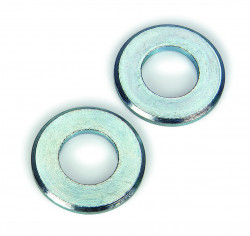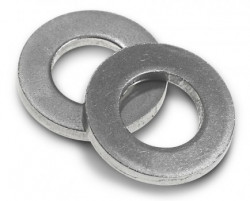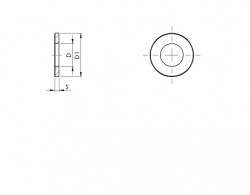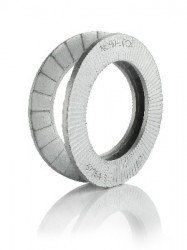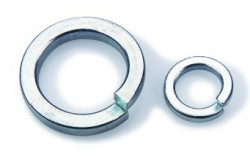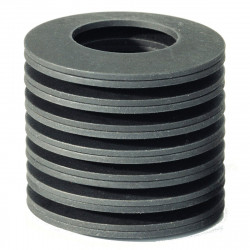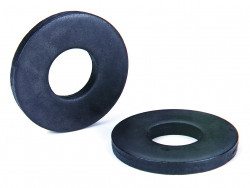Fastening washers: essential for reliable, long-lasting assemblies.
Washers are essential for securing your assemblies, distributing clamping pressure and protecting surfaces from deformation. We offer a wide choice of washers for all your industrial, craft and DIY projects.
A Washer for Every Application
Depending on your needs, choose from a range of washers, each designed for a specific application:
- Flat washers (steel, stainless steel, brass and nylon): Essential for distributing pressure under the screw head or nut.
Zinc-plated steel for standard environments, stainless steel for corrosion resistance, brass for an aesthetic touch and nylon for electrical insulation and lightness. - Nord-Lock washers: The high-performance solution for securing your assemblies, even under intense vibration. Their friction locking system guarantees an infallible hold.
- Steel and stainless steel locking washers: Designed to prevent accidental loosening, they are ideal for installations subject to frequent movement.
- Spring/elastic washers: Perfect for maintaining constant pressure, they absorb shocks and compensate for load variations.
- Clamping washers: Essential for precise clamping, they prevent slipping and ensure firm locking.
Materials for every environment
To guarantee performance and durability, our washers are available in a range of materials:
- Zinc-plated steel: Corrosion-resistant for conventional indoor environments.
- Stainless steel (A2 and A4): Ideal for damp or outdoor environments, with excellent resistance to oxidation.
- Brass: Appreciated for its electrical conductivity and decorative appearance, while offering good corrosion resistance.
- Nylon: Lightweight, insulating and resistant to chemicals, perfect for specific fasteners.
Find your washers in a few clicks
On tdi.fr, it's never been easier to find the washer you need. Filter by type, material or diameter, and find the right product for your project in an instant. Need a helping hand? Our team is here to guide you. With stock on hand at all times and fast delivery, you can get on with your job with complete peace of mind.
What is a washer?
A washer is a small, usually flat, disc with a hole in its center, used to strengthen the bond between a screw, bolt or nut and the supporting material. It distributes the pressure exerted by tightening, protects the contact surface and, depending on its type, can also prevent loosening.
What does a washer do?
The main role of a washer is to :
- Distribute the clampingload to prevent damage to materials.
- Stabilize the assembly by creating a flat bearing surface under the screw head or nut.
- Prevent loosening, by using lock washers or spring washers.
- Ensure watertightness, using special washers such as rubber or combination washers.
Why use a washer with a nut?
The washer prevents the nut from marking or damaging the surface of the material. It distributes pressure for uniform tightening and, depending on the type, can also prevent loosening due to vibration.
What is the function of the lock washer?
The lock washer, like the Grower or Nord-Lock washer, prevents the screw or nut from loosening under the effect of vibration. It acts like a spring, exerting a constant pressure on the assembly.
What material should I choose for my washer?
The choice of material depends on the environment and the application:
-
Zinc-plated steel: Good value for money for indoor use.
-
Stainless steel (A2 or A4): Corrosion-resistant, perfect for outdoor and wet environments.
-
Brass: Aesthetic, good electrical conductivity, ideal for decorative or electrical installations.
-
Nylon: Lightweight, electrically insulating and resistant to chemicals.
What types of washers are there?
There are several types of washers suitable for different uses:
-
Flat washers: Standard, used for load distribution. Available in steel, stainless steel, brass and nylon.
-
Lock washers: Prevent loosening, like Grower or notched washers.
-
Nord-Lock washers: Secure assemblies subject to intense vibration.
-
Spring washers: Maintain tension and absorb shocks.
-
Sealing washers: Protect assemblies from moisture and dust.
-
Clamping washers: provide precise clamping to prevent slipping.
How do I install a washer?
Installing a washer is simple:
- Slide the washer onto the screw before fastening.
- Place the screw in the hole in the material to be assembled.
- If you're using a nut, place another washer between the nut and the surface to distribute the pressure on both sides.
- Tighten firmly, but not excessively, to avoid deforming the washer.
How to unscrew a washer
To remove a washer :
- Unscrew the nut or screw.
- If the washer is stuck, use a flathead screwdriver to pry it out.
- If the washer is rusted or jammed, apply a lubricant to facilitate removal.







